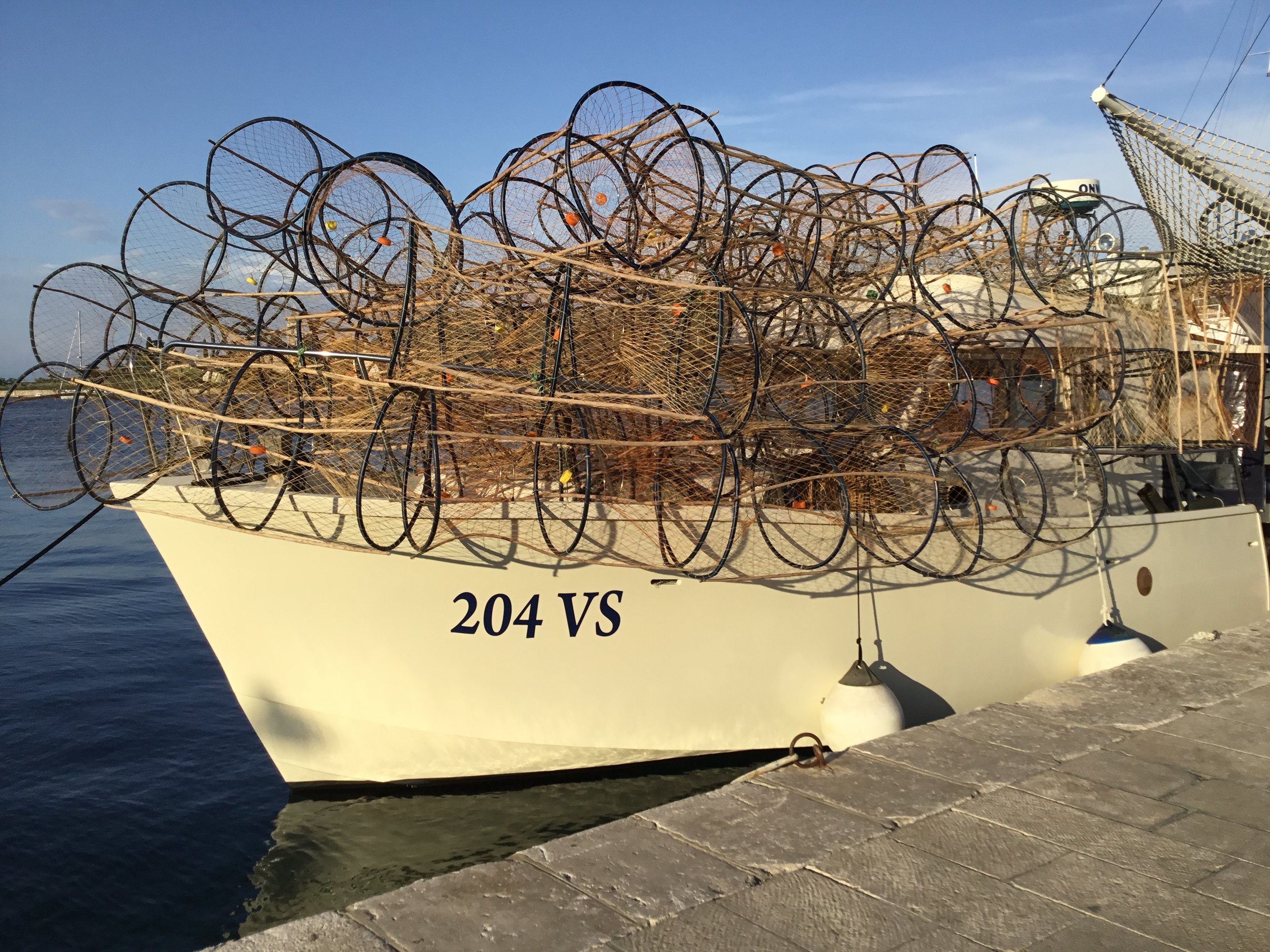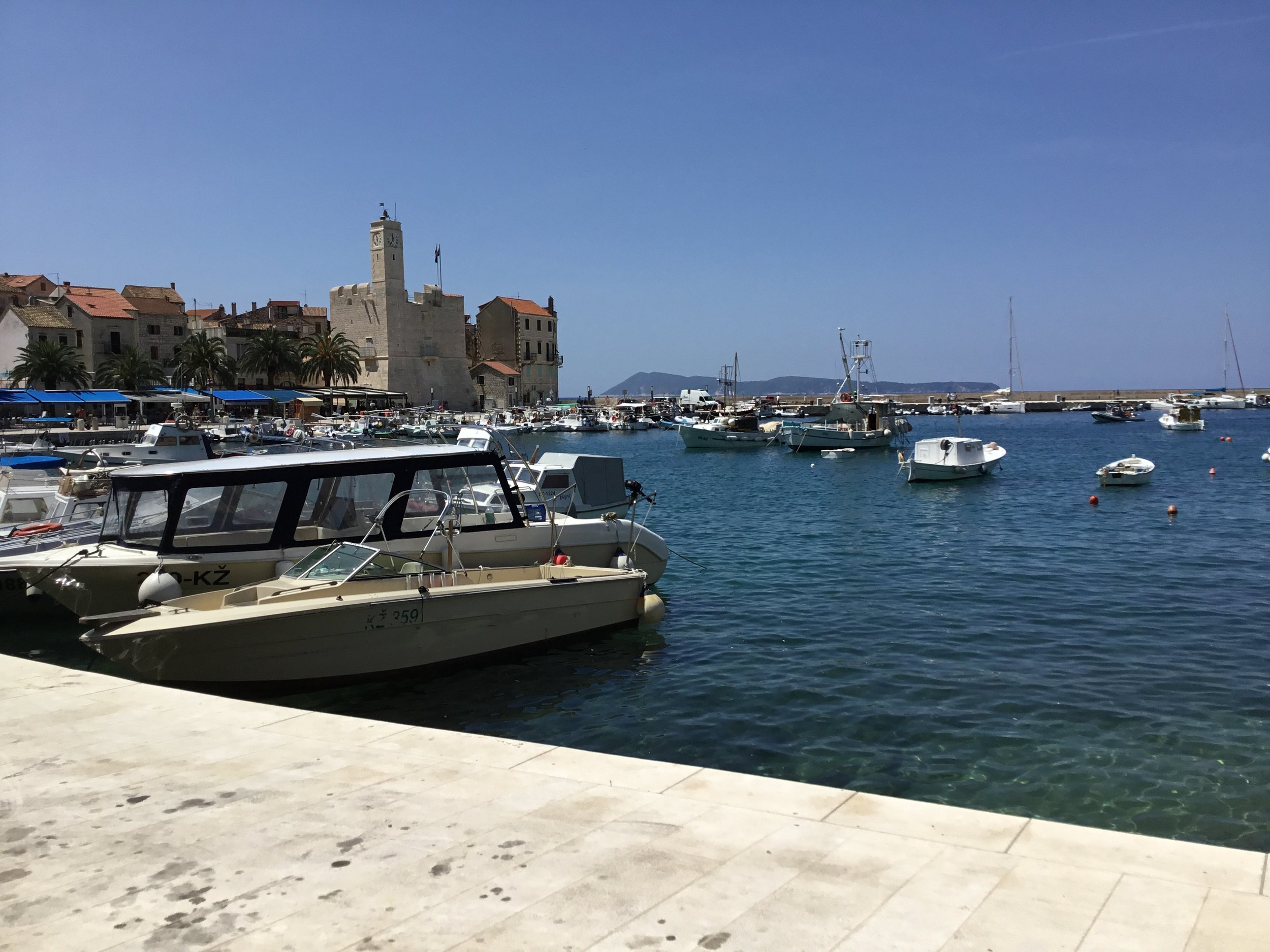v i s
Vis Island is a small, remote island in the Adriatic Sea, part of Croatia’s Dalmatian archipelago. Known for its unspoiled beauty and rich history, Vis has long attracted travelers seeking a more authentic and peaceful escape compared to more tourist-heavy Croatian destinations like Hvar or Dubrovnik. Its isolation—partly due to being a military base closed to foreigners until 1989—has helped preserve the island’s traditional culture, architecture, and environment.
The island is known for its rugged coastline, crystal-clear waters, and secluded beaches such as Stiniva Cove and Srebrna Beach. One of the most famous nearby attractions is the Blue Cave (Modra spilja) on the neighboring islet of Bisevo, where sunlight creates a mesmerising blue glow inside the grotto.
Vis also has deep historical significance. It was a strategic naval base in World War II, and its underground military tunnels can still be toured today. The island has been inhabited since ancient times, originally by the Greeks, who founded the colony of Issa in the 4th century BC. Roman and Venetian influences also left a mark on the island's architecture and culture.
Today, Vis is known for its slow pace, local wines (especially the indigenous Vugava and Plavac Mali varieties), and fresh seafood. Towns like Vis and Komiza offer charming harbours, stone houses, and family-run konobas (traditional taverns), making the island a unique blend of history, nature, and gastronomy.
The best way to reach Vis Island from Split is to take the Jadrolinija ferry departing from Split harbour, the harbour also serves as the main bus terminal, which makes it rather chaotic at times.
You can opt for the ferry or catamaran options. We took the fastest choice which is the catamaran at 1.5 hours (€9,70) as opposed to 2.5 hours by ferry (€9,10). The catamaran can be rather bumpy which is part of the fun, but if you’re the type who gets seasick in the bath then you better take the ferry.
Make sure you arrive at the harbour at least half an hour before departure so that you can find out which jetty your vessel will be leaving from. I would recommend purchasing your ticket a day or two before departure, especially in the high season. Though many people buy their tickets months ahead so as to avoid disappointment, see link above.
Arriving in Vis just after 6pm we headed south of the harbour and southeast along the promenade, past the Archaeological Museum of Vis, to our accommodation in Kut, which is a village and part of greater Vis town.
Luka which where you find the harbour is the main part of town and is definitely more developed. Whereas Kut is the older and more romantic section of Vis Town. A charming, quieter old quarter with Venetian architecture, stone-paved alleys, and a laid-back vibe. Full of traditional Dalmatian houses, palm-lined promenades, and cozy konobas. Great for evening strolls, romantic dinners and local wine tasting.
For beaches in the area, well there’s pretty much just the one in town, Prirovo Beach. It’s situated on the eastern side of Peninsula Prilovo, north of the harbour, jutting out into the bay. Check out Alavia Bar just off the beach. Take time to visit the very pretty Church of St Jerome. Just north of the peninsula you will find the ancient Greek town of Issa.
Back in town check out Pojoda (+385 21 711 575) A legendary family-run spot known for slow-cooked seafood and authentic Vis cuisine in a shaded courtyard. Villa Kaliopa (+385 91 271 1755) Romantic garden setting, Mediterranean dishes, fresh local ingredients. Konoba Kantun (+385 92 285 4818) Cozy, intimate, excellent local wines and seafood. Lambik Restaurant & Wine Bar (yay a website) – A short walk from Kut, this offers house-made wines and organic cuisine.
Try Vugava (indigenous white wine) and Plavac Mali (robust red). Local specialties include grilled fish, pasticada, octopus peka, and viska pogača (a savoury pie with anchovies and onion). In the height of the season definitely book ahead for all these lovely places.
Many of you foodies out there will no doubt come across the “peka” when they research the island of Vis island. In Croatian cuisine, peka refers to both a cooking method and a specific dish. It involves slow-cooking meat (like lamb, veal, or octopus) and vegetables under a bell-shaped dome (also called peka) placed over an open fire. The dome, often made of cast iron or steel, traps heat and allows the ingredients to cook in their own juices, resulting in a tender and flavourful meal.
We had our peka experience up in the hills overlooking Vis town at Roki’s Winery and Restaurant (+385 98 303 483) We were picked up by their shuttle bus and transported to the lovely konoba, think rustic charm, gingam tablecloths, vines tumbling from tresses overhead. Preordering your type of peka is advised, you can choose between lamb, veal or seafood peka. We made a special request for just monkfish which they gladly made for us, we’re not big fans of octopus.
They also have an interesting bar that has quite a number of pieces of cricket memorabilia.
Cricket has a unique history on the island of Vis in Croatia, where it was introduced by British naval officers in the 19th century and has recently seen a resurgence as a popular sport and tourist attraction. Captain William Hoste and his troops stationed on Vis during the Napoleonic Wars played cricket to relieve boredom and boost morale. Although the sport largely disappeared after the British left, it was revived in the 1990s by a returning Australian Croat, Niko Roki, and his son Oliver. Today, Vis Cricket Club hosts international tournaments and is a draw for cricket enthusiasts from around the world.
Vis Island is historically significant as a wartime base for Josip Broz Tito, the leader of the Yugoslav Partisan resistance movement during World War II. He used the island as a secret headquarters, and the island is riddled with tunnels and bunkers built to protect him from potential attacks. Today, these remnants of military history are open to tourists. A cave on Mount Hum served as Tito’s headquarters during the war. It was a place where he and his Partisans planned attacks and devised strategies. The island’s strategic location, being one of the most remote in the Adriatic, made it a valuable asset during wartime. Vis was heavily fortified during the war, with numerous tunnels and bunkers constructed to protect against potential attacks. These military structures, including a submarine tunnel, are now open for exploration.
The British built the airstrips found in the interior of Vis island. They actually levelled out a huge area of land on the plateau, somehow hiding it from view of the German Luftwaffe who flew overhead. Then after WW2 Tito used it as a based for the Yugoslav Partisan airforce, and finally turned it into a secret based during his time as the dictator of Yugoslavia. Though of course the British must have know of it’s whereabouts. Confused? I am.
Anyway, after Tito’s demise the locals duly assumed ownership of this area and turned it into a productive agriculture and winery area. And the rest they say is “history”.
Tucked on the western coast of Vis Island, Komiza is a sleepy fishing village that has evolved into a favourite spot for travellers seeking authenticity, natural beauty, and a slower pace. Compared to Vis Town, Komiza has a more bohemian, relaxed vibe, with narrow alleys, stone houses, and a lively waterfront dotted with cafes and boats. Komiza has several stunning and swimmable beaches nearby — Gusarica Beach: Just a short walk north of town, ideal for families. Kamenice Beach: Known for its natural volcanic pebbles and a beach bar — great for sunsets and cocktails. Nova Posta: A more secluded cove for swimming and relaxing.
Stroll the Old Town, wander through cobbled alleys, discover hidden courtyards, and admire traditional Dalmatian architecture. Don’t miss the Church of Our Lady of the Pirates (Gospa Gusarica), linked to a local legend of pirates stealing an icon.
Fishermen’s Museum (Ribarski muzej) Housed in a 16th-century Venetian fortress (Komuna) offers a fascinating insight into the island’s centuries-old fishing traditions, and home to the only preserved falkusa, a traditional Vis fishing boat.
From Vis Town, it’s a 15-20 minute drive or bus ride to Komiza (buses align with ferry arrivals).
We also had a fab day sailing out to the Blue Cave (Modra spilja) – Bisevo Island which is a must-see natural phenomenon near Vis. The cave glows with an electric blue light at certain times of day. Take a boat tour from Komiza or Vis Town. Our tour also stopped by Stiniva Cove - a stunning, narrow pebble beach enclosed by high cliffs. Often listed among the most beautiful beaches in Europe. The final stop was at Tito’s secret submarine base.
Again, there are many day tours available in and around Vis, you can either book them when you arrive, or prebook them before you leave home. GetYourGuide and Viator offer tours to the Blue Caves, island hopping, wine and food tours. Also Tripadvisor offer the same as above with the additional options of restaurant, hotel, flight, cruise and car-hire.
For more information on Vis and surrounding areas check out this website.
And finally, Lonely Planet for their excellent guidebooks.






